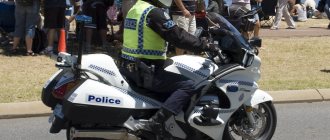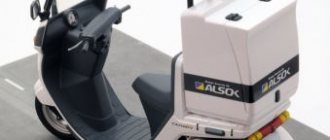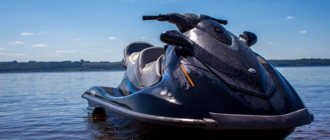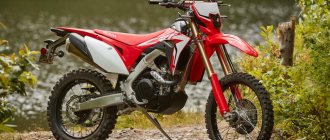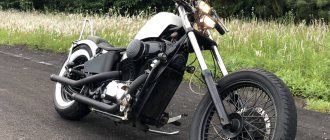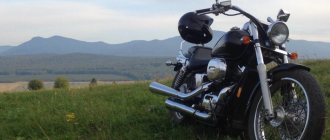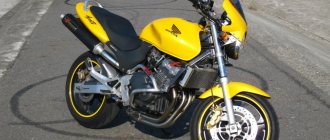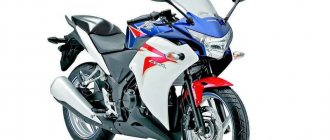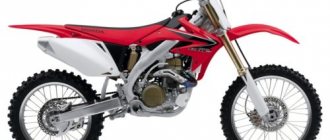What makes a successful vehicle model? Motor? Suspension? Duration of release? No. Even with all the advantages, the model may seem like a failure.
But if the traffic police like it, its success is guaranteed.
This is exactly what the Honda ST 1100 Pan European became. Having appeared in 1990, the police in England and America liked it so much that two years later the developers presented a special model - Honda ST 1100 Police . A different color, a more powerful engine and a different instrument panel distinguished the policeman.
Prototype of the ST 1100 model
At the same time, the prototype for it was the concern’s model about which legends were made - the Honda Gold Wing.
The legendary “Golda” has been produced for more than 40 years and during this time has acquired a huge army of fans.
Initially planned as a cheaper analogue of the “Wing”, Pan European has become a completely new solution that is in demand, despite the fact that it is outdated, archaic, etc.
A clear indication of its quality is the lesser success of the newer Pan European 1300.
ST in the name Sport Touring is a subtle hint that the model is ideal for long-distance driving and long years in the owner’s garage. This confirms the presence of side cases, a high windshield and a huge gas tank already included in the factory configuration.
Tourist option – Honda ST 1100 Pan European.
Police version - Honda ST 1100 Police.
Pan European or pannochka, as the owners called her, lived on the assembly line until 2002 . The police counterpart outlived her by a year.
Specifications
An interesting feature was the timing drive solution. A gear drive was added in parallel to the standard belt solution.
The developers explained that if the belt breaks, you can drive further. The gears are designed to operate independently. Otherwise, the bike did not receive any special solutions. 4-stroke engine was installed on it .
The engine is deployed across the frame, and the clutch is located in the front part.
The arrangement of the pistons is V-shaped , the angle between them is 90 0. It gave:
engine, the following parameters:
- working volume - 1085 cm3;
- power - 100 (98) hp;
- number of valves - 16;
- cylinders - 4;
- cooling - liquid;
- fuel supply - carburetor (Keihin, 32 mm);
- ignition - transistor;
- start - electric starter;
- fuel tank - 28 l.
To comply with European traffic safety laws, the Japanese slightly throttled the engine . The bikes sent to America had 100 mares “under the hood”. European - 98 hp The Japanese cheated - the engine remained at the same power. Light tuning increased torque, but decreased power.
Transmission and clutch
The motorcycle was equipped with a 5-speed gearbox. It has a smooth ride, precise gear shifting and, as a rule, did not cause any problems.
Gear shift pedal.
The gear ratios were chosen in such a way that the first few gears had to be changed frequently, but once in third, you could ride further like on a scooter - adjusting the speed only by turning the throttle. It varied widely from 17 to 170 km .
But users noted one feature . It is not recommended to turn up the speed in the first gears, otherwise the next ones will turn on poorly - ultimately repairing the gearbox.
- The clutch is standard - multi-plate, oil bath.
- Drive - cardan shaft.
Brakes
For unification, the diameter of the disks on both axles is the same. The appearance of ABS and traction control in 1992-93 did not affect the settings. Drive - hydraulics.
Front brakes.
Rear brake disc.
Front brakes:
- number of disks - 2;
- diameter - 296 mm;
- support - 2-piston (since 1995 - 3).
Rear brakes:
- number of disks - 1;
- diameter - 296 mm;
- support - 2-piston (since 1995 - 3).
In 1995, the motorcycle received combi-brakes . For proper functioning, an additional, third piston appears on each bracket.
MY MOTORCYCLE
I owned Pan for a short time, a little less than three years. But he left a lot of impressions! And 99% are positive! In three seasons, I covered a little more than 90,000 km on it. Mainly long rangers. Home is work, in the city it’s the same, but without fanaticism. I don’t like the city crowd... Honda ST1100 is a 100% touring motorcycle! With all the consequences. Landing. Wind protection. Equipment. Everything about him suggests that his element and home are long straight lines to the horizon with good! asphalt surface. Only on the track can you realize its full potential and understand what a touring motorcycle should be like. But first things first.
Appearance. By modern standards it is certainly outdated.
And some will find it unattractive, and may even discourage them from purchasing. But I want to say that behind such a nondescript and simple “face”, there is hidden the most thoughtful ease of maintenance, ergonomics and reliability. Nothing superfluous and everything in its place. Ergonomics. The fit on it is classic. Almost vertical. With a slight forward bend. With excellent wind protection. When it rains, you drive absolutely dry and clean. It doesn’t blow anywhere and doesn’t flood. So does the passenger. But I recommend installing deflectors on the mirrors and on the sidewalls. With them the level of comfort is even higher! The control buttons on the remotes are in the usual places and will not reveal anything new for the owner. But personally, in place of the right remote control, I installed the switch control unit from the police version. With a safe engine shutdown and additional buttons to which I connected the fog lights and motorcycle lights. Such a control unit can be bought on English eBay. It's inexpensive. But the connection took me almost half a day, since I had to resolder the contacts and shorten the wiring a little. You can see in the photo below... The saddle has no adjustments. Wide. Soft and comfortable enough for both the pilot and the passenger. The instruments are located high and you don’t have to lower your head to read their readings.
They just sparkle in the sun. During the day, if the sunlight falls from behind, then practically nothing is visible. I also recommend changing the backlight bulbs to LEDs with five diodes. The mirrors are located at waist level and will take some getting used to at first. They are adjustable over a very wide range and allow you to clearly see the situation behind you. BUT! The mirrors are attached to the body with three iron latching pins and when hitting a good bump they more than fly off onto the asphalt, cracking and scratching. Therefore, I recommend tying the mirrors to the eyelets under them with a regular underwear elastic band. Then, if they fly away, they will hang on these elastic bands and will not fall anywhere. I don't recommend plastic ties. I also tied them, even thick ones, but they tore.
The light from the headlight, even if there are two bulbs there, is not enough. I installed more powerful lamps. Did not help. Only installing bi-xenon and fog lights saved it. There was a lot of light and the road was clearly visible at night. It has enough space for installing ignition units under the “face”.
The original side cases are not that large in volume, so you can’t do without a central case when traveling. Also, the side cases do not have the most reliable fastening, although they are closed from below with a clasp lock. I had a couple of times when the lock opened on a bump and the trunks flew away... Naturally they broke and cracked. Therefore, I recommend tying the panniers by the handles to the rear passenger handrails with leather straps. This is quite aesthetically pleasing and even if the lock opens, the case will remain in place, since the leather is elastic and will not tear, as if it were tied with a plastic tie, for example. By the way, I never removed the panniers. In traffic jams, if the face of a motorcycle passes through the mirrors, then the rear will also pass. Mirrors are a kind of indicator of the width of the motorcycle. Well, the biggest plus of this motorcycle is the tank! 29 liters! That, with a moderate average consumption of 6 liters, is enough for almost 500 km!
Engine and transmission. “V”-shaped with four cylinders! The motor is simply fantastic! With soft work. No vibrations. With a pleasant rustling sound. During the entire period of use, nothing broke in it. Scheduled maintenance only. I read on the English forum of EuroPanov owners that Honda ST1100 engines run 300-400,000 km without any serious interventions. One of the most reliable motorcycle engines! The engine has almost car-like traction from the bottom up to the red zone. He has no cutoff. Anyone can use gasoline. I refueled both AI-80 and AI-98. No difference. I mostly drove the AI-95. In the city you can drive in third gear, like an automatic transmission. From 20km/h to 180km/h. It pulls great. The engine has a timing belt drive, the service life of which is about 90,000 km. The clutch is multi-plate and in an oil bath. Very soft and clear. The most interesting thing is that it is located in front of the engine and has a gear drive to the gearbox. To replace the discs, you need to remove the lower skirt and unscrew the clutch housing cover. Everything is very simple and well thought out. In general, in terms of maintenance, the Honda ST1100 is made very simply and affordable. The gearbox is very soft and clear. Shifts are smooth and always in the right place. But at very high speeds, second and third gears may not engage, so I don’t recommend cranking the engine in lower gears. The mileage on my motorcycle was almost 200,000 km, but it did not consume oil. I didn’t add any more. From replacement to replacement (10,000 km), the level always remained level. The cardan drive only increases the degree of reliability and unpretentiousness. Every time at the beginning of the season I filled in 150g of oil and no problems. I didn’t even think about him, and he didn’t remind me of himself. As a rule, all motorcycle stores for the Honda ST1100 have all filters and pads in stock. But some consumables will have to be ordered.
Frame and suspension. The duplex frame speaks for itself that the stability of the motorcycle in long turns, especially with bumps, is not the best. The motorcycle begins to wobble, which can lead to wobbling. Therefore, the speed in a turn must be selected according to the quality of the asphalt. In addition, it has to be laid by force. In a straight line it goes very smoothly and smoothly, like a locomotive. Swallowing bumps and swaying a little, like an American Lincoln of the 80s. In general, the suspension of the 1100th Pan is weak. The front fork “walks” at low speed and seems to twist and break when turning/turning. Despite the fact that it was properly maintained. The heavy weight of the motorcycle and the thin 39mm front fork stays have an effect. Installing a third traverse may make this moment a little easier, but not by much. After riding a motorcycle with this addition, I realized that there was no point in installing it. The rear shock absorber is also archaic and simple. If you drive together, loaded with camping gear, the suspension gets hit very hard, even with the shock absorber tightened up. Sparks are generated from the center stand. The rear swingarm must be periodically inspected for rust (bottom) and bearing play. This is the weak point of this motorcycle.
Brakes. On mine there were the simplest ones without ABS and not combined ones. Frankly speaking, I missed them. After a couple of extreme braking they overheat and become “wobbly”. For such a heavy motorcycle, with such speed capabilities, this is a huge minus! Therefore, I recommend buying a motorcycle with a combined brake system and ABS. There they are much more informative and more tenacious with less effort on the lever. Pads are always available in motorcycle stores, both original and non-original.
Electrical equipment. On motorcycles before 1997, the generator has a power of 20A. Which is very little. You can install a heated steering wheel and a couple of PTFs... but nothing more. Since 1997, generators began to be installed at 40A, which greatly simplifies the operation of the motorcycle and the ability to connect additional electrical equipment. But despite everything, 20-amp generators are also very reliable and there are very few cases of their breakdowns. Replacing all incandescent light bulbs with diode ones, plus installing xenon in the headlight, will significantly lighten the load and give a couple of extra “free” watts for charging the phone, which I placed in the left side compartment near the false tank. Installing a 40-amp generator instead of a 20A is possible, but you will have to make an adapter because there are slight differences in the mounting locations. Details about such operations are written on the English forum of Honda ST1100 owners.
Source: bikeswiki.ru
Driving performance
Excellent driving characteristics, a durable engine with a long service life - all this made the Honda ST 1100 one of the leaders in its class.
The maximum declared speed is 210 km/h . The police versions accelerated so that the arrow lay down , but such a bike was not sold to the average user.
Acceleration to hundreds
Acceleration from zero to 100 km - 4 seconds .
Fuel consumption
Fuel consumption depended on the conditions of use. From 4 liters for leisurely city driving to 8 liters for those who like to play catch-up.
Dimensions and weight
Since the Japanese assembled the bike according to the laws of each export country, the mass of the motorcycle was floating.
Dry weight:
- 283 kg - Canada, without combi-breaks, ABS, traction control.
- 299 kg - California, full minced meat.
Curb bike:
- 312 - Canada, without combi-brakes, ABS, traction control.
- 322 - Canada, complete mincemeat.
- 318 - California, clean.
- 328 - California, complete mincemeat.
Despite this variation in weight, the overall dimensions did not change. The bike had:
- length - 2294 mm ;
- width - 835 (by saddlebags), 935 (by mirrors) mm ;
- height - 1394, 1404 (after 1995) mm ;
- saddle height - 800 mm ;
- ground clearance - 143 mm ;
- wheelbase - 1555 mm.
As users have repeatedly noted, mirrors are the best indicators for shooting between rows. If they pass, the trunks will pass too.
Chassis and brakes
The tubular frame of the ST 1100 is made of steel. It is generally typical for touring models, but in some places there is a tendency towards sports touring bikes, expressed in streamlined outlines. The alloy wheels and steering wheel are fairly typical.
The rear suspension is a monoshock absorber, and the front is a 43 mm telescopic fork. The ST 1100 has combined brakes: at the rear there is a 296 mm disc and a three-piston caliper, and at the front there is a pair of discs, each 296 mm, complete with three-piston calipers. There is ABS.
It must be said that, according to reviews from owners, the brakes of this model work well at 120-130 km/h; with a further increase in speed, their effectiveness decreases significantly.
Who is it suitable for?
Gold Wing and Pan European ST 1100 sell out like ice cream in the summer, but not everyone will find it comfortable, although the sofa they come with will, by definition, be comfortable.
Typically, this motorcycle is purchased for comfortable travel over really long distances.
At the same time, the ST 1100 was designed for a European of average height and a classic, slightly forward-leaning seating position.
Dimensions and weight
The motorcycle has a very significant weight - even without fuel, this machine weighs 298 kg. It's all about the impressive dimensions of this bike, which, however, are generally inherent in classic touring bikes. The tank volume here reaches 28 liters, which is a lot even for a representative of this class. The actual fuel consumption is only 6 liters per hundred.
Competitors
Even though the Pan European was supposed to be the wing's equivalent, Yamaxa and Kawasaki .
Yamaxa GTS 1000.
Kawasaki GTR 1000.
- GTS 1000 in 1993 . It was distinguished from the Pan European by a smaller engine capacity (but higher maximum speed), a standard chain drive, adjustable footrests and fuel injection.
- Kawasaki presented its version of the GTR 1000 earlier than Honda. It did not have ABS, 4 cylinders were arranged in a row, which gave a slight increase in horses (110), had a 6-speed gearbox, and completely indecent fuel consumption - 7 liters for the extra-urban cycle.
Reviews
The most frequently cited disadvantages of the model were:
- a weak generator , which was barely enough for the bike’s own electrics. (In 1995 it was replaced with a more powerful one).
- mounting of mirrors , which had to be modified so as not to buy new ones.
- weak rear shock absorber not designed for traveling with two people with full standard panniers.
Rod wear and corrosion is another fairly common rear shock problem.
Like any other model, individual owners could cite more disadvantages for each specific unit.
Advantages
The advantages of the motorcycle included both technical and external advantages.
- powerful, indestructible motor;
- soft and clear gearbox;
- cardan;
- comfortable, large seat;
- classic landing (slightly tilted forward);
- similarity to Gold Wing;
- illumination, like Gold Wing.
